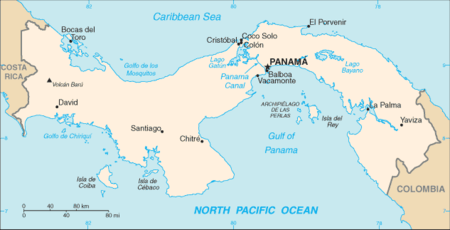Land bridge
A land bridge, in biogeography, is an isthmus or wider land connection between otherwise separate areas, over which animals and plants are able to cross and colonise new lands. A land bridge can be created by marine regression, in which sea levels fall, exposing shallow, previously submerged sections of continental shelf; or when new land is created by plate tectonics; or occasionally when the sea floor rises due to post-glacial rebound after an ice age.

Prominent examples
- Adam's Bridge (known as Rama Setu), connecting India and Sri Lanka
- The Bering land bridge, which intermittently connected Asia with North America as sea levels rose and fell under the effect of ice ages
- Doggerland, a former landmass in the southern North Sea which connected the island of Great Britain to mainland Europe during the last ice age
- The Isthmus of Panama, whose appearance three million years ago allowed the Great American Interchange
- The Sinai Peninsula, linking Africa and Eurasia
Land bridge theory
In the 19th century a number of scientists noted puzzling geological and zoological similarities between widely separated areas. To solve these problems, "whenever geologists and paleontologists were at a loss to explain the obvious transoceanic similarities of life that they deduced from the fossil records, they sharpened their pencils and sketched land bridges between appropriate continents."[1] The concept was first proposed by Jules Marcou in Lettres sur les roches du Jura et leur distribution géographique dans les deux hémisphères ("Letters on the rocks of the Jura [Mountains] and their geographic distribution in the two hemispheres"), 1857–1860.[2]
The hypothetical land bridges included:[1]
- Archatlantis from the West Indies to North Africa
- Archhelenis from Brazil to South Africa
- Archiboreis in the North Atlantic
- Archigalenis from Central America through Hawaii to Northeast Asia
- Archinotis from South America to Antarctica
- Lemuria in the Indian Ocean
The theory of continental drift provided an alternate explanation that did not require land bridges. However the continental drift theory was not widely accepted until the development of plate tectonics in the early 1960s, which more completely explained the motion of continents over geological time.
See also
References
- Corliss, William R. (June 1975). Mysteries Beneath the Sea. Apollo Editions. ISBN 978-0815203735. Chapter 5: "Up-and-Down Landbridges".
- Corliss, William R. (June 1975). Mysteries Beneath the Sea. Apollo Editions. ISBN 978-0815203735. Chapter 5: "Up-and-Down Landbridges". "The basic idea is usually attributed to Jules Marcou..."
External links
| Look up land bridge in Wiktionary, the free dictionary. |
- Ernest Ingersoll (1920). . Encyclopedia Americana.